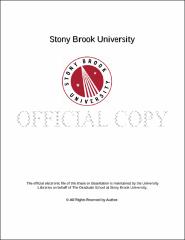| dc.identifier.uri | http://hdl.handle.net/1951/60244 | |
| dc.identifier.uri | http://hdl.handle.net/11401/71502 | |
| dc.description.sponsorship | This work is sponsored by the Stony Brook University Graduate School in compliance with the requirements for completion of degree. | en_US |
| dc.format | Monograph | |
| dc.format.medium | Electronic Resource | en_US |
| dc.language.iso | en_US | |
| dc.publisher | The Graduate School, Stony Brook University: Stony Brook, NY. | |
| dc.type | Dissertation | |
| dcterms.abstract | Autophagy is an evolutionarily conserved membrane trafficking process that maintains cell and tissue homeostasis. Autophagy plays essential roles in response to starvation and stress, and is involved in organelle homeostasis. Dysregulation of autophagy is implicated in diseases such as neurodegeneration and cancer. The induction of autophagy depends on phosphatidylinositol 3-phosphate (PI(3)P), the product of the Class III Phosphatidylinositol 3-Kinase (PI3K), Vps34. In metazoans, autophagy is thought to be inhibited by Class I PI3Ks, which are activated by cell surface trophic factor receptors and produce PI(3,4,5)P3 that activates the Akt-TOR kinase cascade and negatively regulates autophagy. Class IA PI3Ks are heterodimeric proteins consisting of an 85-kD regulatory subunit and a 110-kD catalytic subunit. During the course of my dissertation research, I discovered a previously unknown role of the Class IA p110-beta catalytic subunit as a positive regulator of autophagy. Upon trophic factor limitation, p110-beta dissociates from trophic factor receptor complexes, and increases its interaction with the small GTPase Rab5. This p110-beta-Rab5 association sequesters Rab5 from its GTPase activating proteins and enhances the Rab5-Vps34 interaction, which in turn activates Vps34 and promotes autophagy. Genetic deletion of p110-beta results in impaired autophagy in mouse embryonic fibroblasts, liver, and heart. This p110-beta-mediated autophagy is independent of the Akt-TOR pathway. These results unveiled a previously unknown function for p110-beta as a positive regulator of autophagy, and suggested a new mechanism of autophagy induction in response to trophic factor limitation. | |
| dcterms.available | 2013-05-24T16:38:17Z | |
| dcterms.available | 2015-04-24T14:47:46Z | |
| dcterms.contributor | Zong, Wei-Xing | en_US |
| dcterms.contributor | Lin, Richard Z | en_US |
| dcterms.contributor | Brown, Deborah A | en_US |
| dcterms.contributor | Frohman, Michael A | en_US |
| dcterms.contributor | Crawford, Howard C | en_US |
| dcterms.creator | Dou, Zhixun | |
| dcterms.dateAccepted | 2013-05-24T16:38:17Z | |
| dcterms.dateAccepted | 2015-04-24T14:47:46Z | |
| dcterms.dateSubmitted | 2013-05-24T16:38:17Z | |
| dcterms.dateSubmitted | 2015-04-24T14:47:46Z | |
| dcterms.description | Department of Molecular and Cellular Biology | en_US |
| dcterms.extent | 108 pg. | en_US |
| dcterms.format | Monograph | |
| dcterms.format | Application/PDF | en_US |
| dcterms.identifier | http://hdl.handle.net/1951/60244 | |
| dcterms.identifier | http://hdl.handle.net/11401/71502 | |
| dcterms.issued | 2012-08-01 | |
| dcterms.language | en_US | |
| dcterms.provenance | Made available in DSpace on 2013-05-24T16:38:17Z (GMT). No. of bitstreams: 1
StonyBrookUniversityETDPageEmbargo_20130517082608_116839.pdf: 41286 bytes, checksum: 425a156df10bbe213bfdf4d175026e82 (MD5)
Previous issue date: 1 | en |
| dcterms.provenance | Made available in DSpace on 2015-04-24T14:47:46Z (GMT). No. of bitstreams: 3
StonyBrookUniversityETDPageEmbargo_20130517082608_116839.pdf.jpg: 1934 bytes, checksum: c116f0e1e7be19420106a88253e31f2e (MD5)
StonyBrookUniversityETDPageEmbargo_20130517082608_116839.pdf.txt: 336 bytes, checksum: 84c0f8f99f2b4ae66b3cc3ade09ad2e9 (MD5)
StonyBrookUniversityETDPageEmbargo_20130517082608_116839.pdf: 41286 bytes, checksum: 425a156df10bbe213bfdf4d175026e82 (MD5)
Previous issue date: 1 | en |
| dcterms.publisher | The Graduate School, Stony Brook University: Stony Brook, NY. | |
| dcterms.subject | autophagy, growth factor, p110, PI3K, Rab5, Vps34 | |
| dcterms.subject | Cellular biology--Molecular biology--Medicine | |
| dcterms.title | Study of Phosphatidylinositol 3-Kinase in the Regulation of Autophagy | |
| dcterms.type | Dissertation | |

